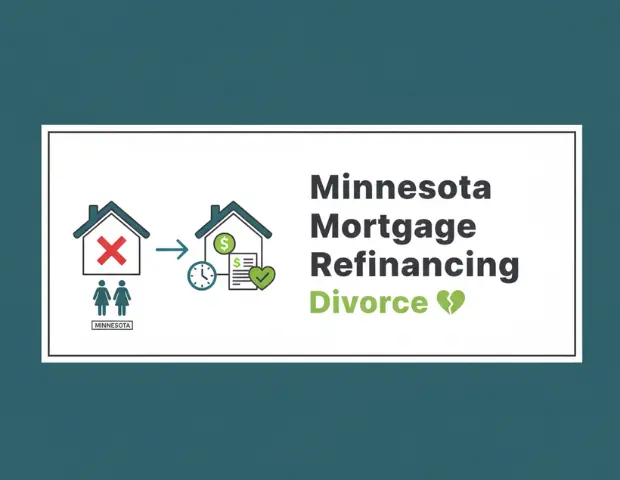
Key Takeaways
- In most Minnesota divorces, the spouse keeping the house must refinance the mortgage into their own name, removing liability from the other spouse; selling or asset offset may be considered when refinancing isn’t feasible.
- Cash-out refinance for a buyout requires strong credit, income, and at least six months (conventional loans) or three months (FHA) of documented support payment if using alimony/child support as income.
- All deadlines, obligations, and contingencies must be clearly stated in the Divorce Decree or Marital Settlement Agreement to prevent disputes or missed opportunities.
- Maintaining timely mortgage payments during separation and divorce is essential for qualifying; missed payments can ruin both parties’ credit and eliminate refinancing possibilities.
- For full guidance, call (612) 590-7896 or email [email protected] or check divorce mortgage options in Minnesota.
Divorce is complicated—and splitting real estate is often the hardest part. In Minnesota, when one spouse wants to keep the marital home, a mortgage refinance isn’t just best practice—it’s typically required by court settlement, lender policy, or both. Here’s a detailed 2025 guide on exactly how this works, what you need, and how to avoid costly mistakes.
Refinancing to Remove an Ex-Spouse: When & Why
Why Refinance?
- Removes the departing spouse from ongoing debt liability, fully protecting their credit.
- Enables the “buyout” of the departing spouse’s equity interest—the most common method if the home is not being sold.
- Allows the spouse keeping the house to manage the mortgage as a solo borrower, with or without new terms.
When Is It Done?
- Before Filing: Easiest option, as you’re still “married” and have greater flexibility and lender cooperation.
- During Divorce Proceedings: More complicated; requires a signed written agreement detailing equity/obligations before approval. Processing often takes longer.
- After the Divorce Is Finalized: Most documentation, as lender must see the full, executed Divorce Decree and Marital Settlement Agreement spelling out all obligations, debts, and asset splits.
What Lenders Require for Divorce Refinancing
- Recent mortgage statement and payoff balance.
- Proof of the buyout figure, if applicable, and settlement paperwork spelling out who pays what (these must be part of your agreement/decree).
- Evidence of income: two years of tax returns, W-2s, current pay stubs, plus (if applicable) at least six months of documented alimony/child support payment receipts; some government-backed loans only require three months.
- Especially for homemakers or job changers: many lenders will not approve a refi unless you have at least two years of employment history, though some “non-QM” lenders allow a refi with at least 20% equity.
- An appraisal to confirm equity before cash-out is allowed.
- Signed, dated quitclaim deed simultaneous with the new closing (transfers title in full to the sole, retaining spouse).
Buyout and Equity Requirements
- Mortgage must be refinanced into one spouse’s name only. The departing spouse receives their share of equity.
- For a limited cash-out refinance, borrower cannot receive “proceeds”—the funds must go toward the ex-spouse’s buyout or joint debts.
- Property must usually have been jointly owned for at least 12 months.
- Post-divorce payments to the ex (maintenance, support, settlement) are considered in your debt-to-income (DTI) ratio and approval.
Timeline and Legal Language
- The court or your Marital Settlement Agreement should include a specific deadline for the refinance or sale (many allow 60-120 days, but some tie the date to a child’s graduation, etc.).
- “Sunset language” is routine—if the refinancing spouse misses a payment during this transition, the agreement may require the home be listed for sale after a set number of missed payments (often 60 days late).
- Both parties may agree to allow child/spousal support to be used directly for the mortgage in emergencies.
Alternatives to Refinancing
- Selling the Home: Both spouses split net proceeds after mortgage, fees, and closing costs. This is the “cleanest” division if neither can qualify to refinance or wants (or can afford) the home.
- Asset Offset: If one party wants to keep the home but can’t or prefers not to refinance, they may use other marital assets (brokerage, retirement, cash) as a trade for their spouse’s equity interest—documented in your Marital Settlement Agreement.
- Mortgage Assumption/Release of Liability: Rare with conventional loans; possible (at lender’s discretion) for FHA/VA/USDA mortgages.
FAQs
How long do I have to refinance after divorce?
Set by your Marital Settlement Agreement or final decree—can range from 60 days to more than a year, depending on your situation and what the court approves.
What if I miss mortgage payments before or during divorce?
Missed payments significantly hurt eligibility and can damage both credit scores.
Who pays refinance closing costs?
Usually the retaining spouse, but some split costs by agreement or through negotiation.
What if I can’t get approved for a refinance?
You may need to sell the house or negotiate an asset offset. Some “non-QM” lenders may help if you have enough equity but lack traditional income or credit.
Conclusion and Guidance
Divorce mortgage refinancing in Minnesota is detail-driven. To protect both parties’ interests, follow each court and lender step with precision: finalize your paperwork, keep current on every obligation, set strict deadlines, and get every buyout or asset arrangement in writing.
For tailored help, call (612) 590-7896, email [email protected], or visit the Minneapolis mortgage Loan Officer. Professional expertise can safeguard your finances and bring clarity to the complexities of divorce and refinancing.
